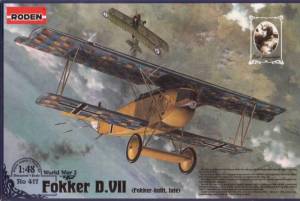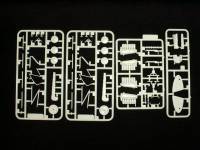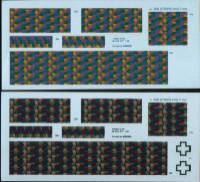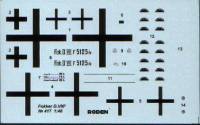Roden 1/48th Fokker D.VIIF (Fokker-built, Late)
|
 |
History
In the autumn of 1917, Germany's Idflieg (aviation inspection section)
scheduled a Fighter Competition with the aim of replacing the aircraft
in action at that time, as the British Sopwith Camel and French SPAD XIII
had made all the existing German scouts obsolete. The Fokker F.1 Triplane
had just arrived at the Front in August of that year, but there were problems
with its wing construction.
Anthony Fokker stepped forward with a new project - the V.11. It was
to be a biplane with cantilever wings that required no external bracing,
and would be powered by a 160 h.p. liquid-cooled Mercedes D.III engine.
 In
January 1918, the V.11 was one of thirty types proposed at the competition,
and it made an impressive showing. Manfred von Richthofen (The Red Baron)
praised the design, but made a few negative remarks that were taken into
account, and the V.11 was modified before the end of the competition.
As a result, the V.11 won the competition. Renamed the D.VII, production
began immediately in Fokker's plants. In
January 1918, the V.11 was one of thirty types proposed at the competition,
and it made an impressive showing. Manfred von Richthofen (The Red Baron)
praised the design, but made a few negative remarks that were taken into
account, and the V.11 was modified before the end of the competition.
As a result, the V.11 won the competition. Renamed the D.VII, production
began immediately in Fokker's plants.
The early D.VII's began arriving at the Front in March 1918, but in
such minimal quantities that only one was given to each Jasta (hunting
squadron.) Usually it was given only to the best aces and most experienced
pilots. Manfred von Richthofen received his in April 1918, but preferred
his Dr.1 triplane, which he was flying when he was shot down.
By July 1918, more than thirty Jastas were operating D.VII's, with a
total of 407 in service. Its combat experience showed that it was the
best fighter of the time. With its higher maximum speed and rugged construction,
it outperformed any existing Allied aircraft. Some D.VII's even returned
from missions without struts or cables! By November 1918, 775 planes had
reached the Front. The majority were the later versions equipped with
the more reliable and powerful Mercedes D.IIIau or BMW IIIa engines.
 More
than 3000 D.VII's were built in Germany, and another 200, powered by the
200 h.p. Austro Daimler engine were built in Austria-Hungary under license.
After the war, many Dutch-built D.VIIs were sent to Belgium, Denmark,
Czechoslovakia, Lithuania, and other countries. Soviet Russia purchased
fifty aircraft, and confiscated planes were delivered to the U.S. Many
were used in the "Aerial Circus" and Hollywood movies. More
than 3000 D.VII's were built in Germany, and another 200, powered by the
200 h.p. Austro Daimler engine were built in Austria-Hungary under license.
After the war, many Dutch-built D.VIIs were sent to Belgium, Denmark,
Czechoslovakia, Lithuania, and other countries. Soviet Russia purchased
fifty aircraft, and confiscated planes were delivered to the U.S. Many
were used in the "Aerial Circus" and Hollywood movies.
The opinion that the D.VII was the best fighter of the war is backed
up by the fact that it was the only airplane listed by name in the conditions
for Germany's surrender in the Treaty of Versailles. It is a fitting tribute
to the engineering genius of Anthony Fokker.
The Kit
I looked at the box and said, "Nice artwork." Then I opened
it and said, "WOW!" Quite frankly, it is probably the best-molded
kit I've seen in a long time. Molded in light gray styrene on six sprues,
it is almost completely flash-free even on the smallest parts, there are
no sink marks, and the ejector pin marks are located where they won't
show. The only exception to this is the pin marks on the inside of the
side engine covers, and these will only show if you choose to leave one
off to expose the engine detail.
 Two
engines are provided, with subtle differences between the two crankcases.
Left on my own I wouldn't know which to use, but the instructions make
this very clear, showing which parts on all sprues are not used this version.
The unused parts will make nice additions to your spares box. Engine brackets
abound, and it remains to be seen if they will mate up well with the engine
in the fuselage. As I mentioned earlier, this section could be easily
detailed sufficiently that you may want to omit one of the side panels
just to show it off. In fact, the instructions seem to show this as an
option. Two
engines are provided, with subtle differences between the two crankcases.
Left on my own I wouldn't know which to use, but the instructions make
this very clear, showing which parts on all sprues are not used this version.
The unused parts will make nice additions to your spares box. Engine brackets
abound, and it remains to be seen if they will mate up well with the engine
in the fuselage. As I mentioned earlier, this section could be easily
detailed sufficiently that you may want to omit one of the side panels
just to show it off. In fact, the instructions seem to show this as an
option.
The wings are molded with separate upper and lower surfaces as well
as separate wing tips. The ribs are very well done, and the bottom surfaces
even have the ribs properly "sucked in" instead of protruding,
as they are normally portrayed. You can verify that this is correct by
visiting your local airport and looking at a "rag-wing." The
surfaces are somewhat rough, perhaps in an attempt to simulate fabric.
If so, this is probably overdone, and may require some light sanding to
tone it down a little. Ailerons and elevator surfaces are molded separately.
No need to worry about cutting them from the wings here.
The cockpit is equipped with a control stick, rudder bar, compass, and
what appears to me to be a machine gun trigger and some control linkage
from the rudder bar aft. The cockpit area of the fuselage has stringer
details molded into it, and looks quite nice.
The four pages of pictorial instructions are well laid-out, but the
steps for assembly of the engine supports are a little confusing. They
may become obvious once assembly is started. I'll let you know.
 Three
propellers are included, and which of the three included schemes you decide
to build will determine the one you use. There are options for Hauptmann
Hermann Goering, Oblt. Bruno Loerzer, and Oblt. Erich Loewenhardt. The
decals are crisply printed and well registered, and appear to be sturdy
enough to apply without disintegrating. Three
propellers are included, and which of the three included schemes you decide
to build will determine the one you use. There are options for Hauptmann
Hermann Goering, Oblt. Bruno Loerzer, and Oblt. Erich Loewenhardt. The
decals are crisply printed and well registered, and appear to be sturdy
enough to apply without disintegrating.
Conclusion
I've heard good things about Roden kits, and judging from this sample,
the praise is well deserved. I have heard some comments about poor fit
in some cases, but a first look doesn't indicate anything major. Any deviation
from this expectation will, of course, be reported in the build review.
With its absence of intricate rigging, anyone with any modeling experience
should be able to turn this into a first-rate model. For those wanting
to take the plunge into WWI modeling, this would be a good starting point
Thanks to Roden for the review
sample.
|
|
